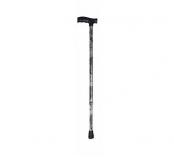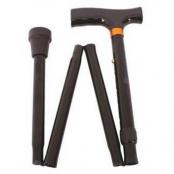Who uses walking sticks.
It is usually the elderly who need to use walking sticks but there are also young adults who may need it as well. For example, those who met an accident or become injured will need the assistance of a walking stick even only during recovery. In this section of our store,
Using a walking stick
There are quite a number of reasons why people use a walking stick. Some use it as an aid for walking or mobility while others use it for fashion. There are also those who use it for hiking, as defense weapon or simply to help facilitate walking.
Folding Walking Sticks
Folding walking sticks are made up of section that can be broken down into parts. Its main advantage is it can be folded up and kept in a bag when not in use. However, folding walking sticks can also have its own drawback -- its folding mechanism makes it susceptible to flexing, especially when used by heavier individuals. This can lead to becoming wobbly therefore less secure. It is most ideal for those who do not need to use a walking stick all the time but have it when needed.
Adjustable Walking Sticks
This can be adjusted to different heights, depending on what is the requirement. It is typically made of aluminum material using a telescopic twist mechanism that allows you to carefully choose the height of the cane that will best suit your use.
Tripod and Quad Legs
This type are built with stability in mind. Designed to allow more weight to be put on them and offer more stability and security as well as balance. Most suitable for those who are recovering from injury in the leg, ankle, or foot. However, one of its limitation is not to be used on stairs. It is also heavier than the usual one footed cane so if you're on the frail side, this may not be very comfortable to use.
Types of Handles:
Crooked or Curved
A very common handle for non-adjustable walking sticks, this type of handle can be slung on a raised arm or hung on a table if not in use. Ideal for those with a firm grip as it is not ergonomically designed.
Derby Handle
A flat handle with a slight curve, it can be slung on arms or table when not in use similar to a crook handle. However the shape provides an easier grip than the crook handle.
Ergonomic or Contoured
Allows the person using it to spread his body weight across his hands instead of concentrating in just a single part. Best suited for those who have arthritis in their hands and puts a lot of weight on walking stick and uses it a lot. Since this is shaped for the palm, it is best to select either a left or right handed handle depending on what hand you will use the walking stick.
T Handle
The most common and standard handle used on many walking sticks. The shape allows your thumb to comfortably wrap around the front of the stick whilst the back of the handle allows easy grip. Suitable for most users.
Swan Handle
Offers more control and stability due to its curved shaft that spreads your weight over the stick.
Escort Handle
Aesthetically pleasant, the tapering design enables a good grip. It is also very popular because of these reasons.
Materials:
Wood
These are walking sticks manufactured with shafts that are made of: chestnut, ash, cherry, hazel, oak or rosewood. Popular today as these were from many years. Wood can be used in most handle types and have solid shafts.
Aluminum
Using lightweight aluminum gives more security for heavier individuals compared to wooden or folding walking sticks. The adjustable type of aluminum walking sticks can be adjusted over a large range with the use of a spring loaded catch. The tripod and quad walking aids are usually manufactured using aluminum.
Page updated 06/04/18 12:47:36 p.m.









